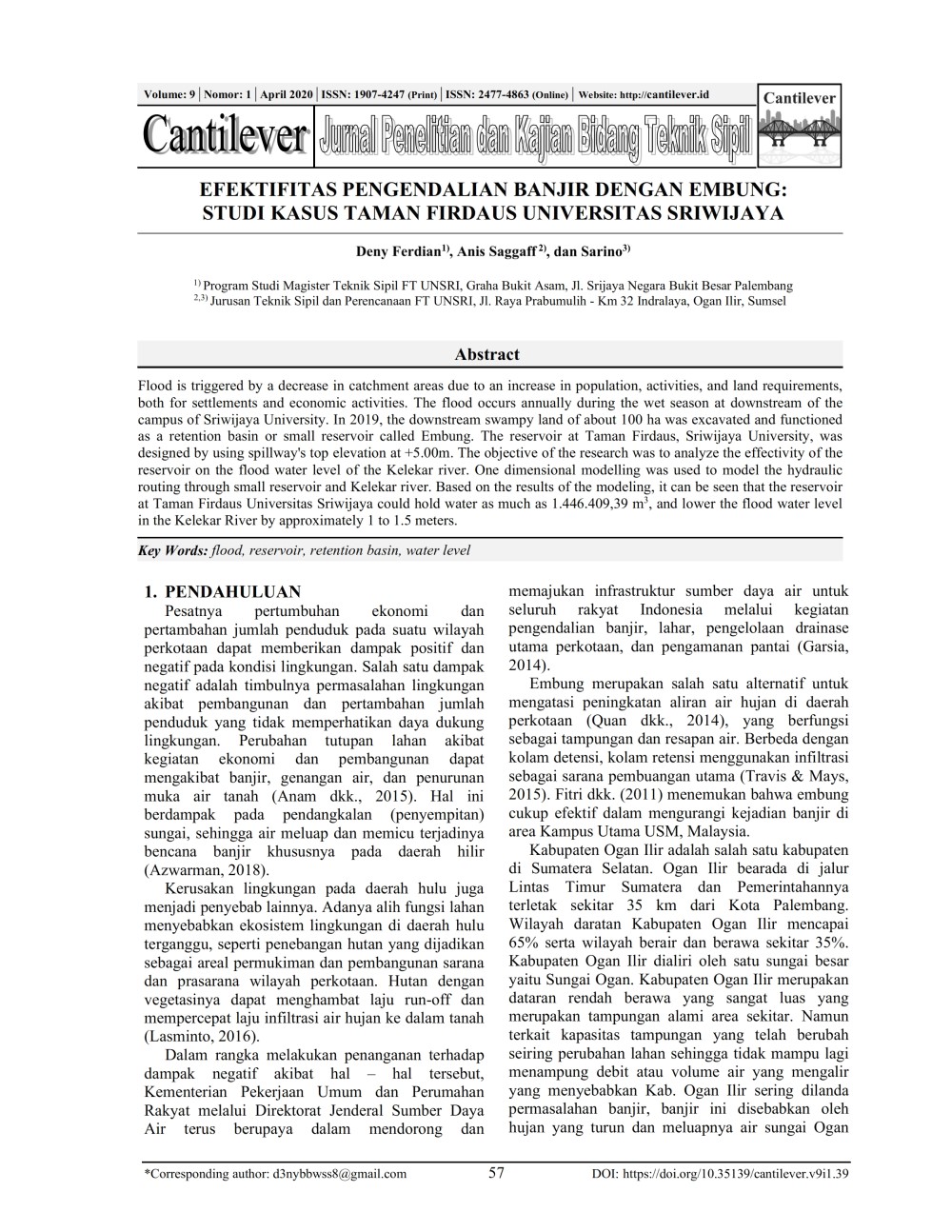Efektifitas Pengendalian Banjir dengan Embung: Studi Kasus Taman Firdaus Universitas Sriwijaya The Effectiveness of Flood Control with a Small Reservoir: A Case Study of Taman Firdaus Sriwijaya University
Main Article Content
Abstract
Flood is triggered by a decrease in catchment areas due to an increase in population, activities, and land requirements, both for settlements and economic activities. The flood occurs annually during the wet season at downstream of the campus of Sriwijaya University. In 2019, the downstream swampy land of about 100 ha was excavated and functioned as a retention basin or small reservoir called Embung. The reservoir at Taman Firdaus, Sriwijaya University, was designed by using spillway's top elevation at +5.00m. The objective of the research was to analyze the effectivity of the reservoir on the flood water level of the Kelekar river. One dimensional modelling was used to model the hydraulic routing through small reservoir and Kelekar river. Based on the results of the modeling, it can be seen that the reservoir at Taman Firdaus Universitas Sriwijaya could hold water as much as 1.446.409,39 m3, and lower the flood water level in the Kelekar River by approximately 1 to 1.5 meters.
Downloads
Article Details
Azwarman (2018). Kajian Teknis Bangunan Pelimpah Embung Pinang Merah di Kabupaten Merangin Provinsi Jambi. Jurnal Civronlit Universitas Batanghari, 3(2), 63-72. DOI: http://dx.doi.org/10.33087/civronlit.v3i2.35.
Sarwono B., Ansori M. B., & Ratnasari, D. A. (2015). Studi Pengendalian Banjir Sungai Kalidawir Tulungangung Jurnal Hidroteknik, 1(1), 13-19.
Fitri, A., Hasan, Z. A., & Ghani, A., A. (2011). Effectiveness of Aman Lake as Flood Retention Ponds in Flood Mitigation Effort: Study Case at USM Main Campus, Malaysia. 3rd International Conference on Managing Rivers in the 21st Century: Sustainable Solutions for Global Crisis of Flooding, Pollution and Water Scarcity, Penang, Malaysia, 6 – 9 Desember 2011.
Garsia, D., Sujatmoko, B., & Rinaldi (2014). Analisis Kapasitas Tampungan Embung Bulakan untuk Memenuhi Kekurangan Kebutuhan Air Irigasi di Kecamatan Payakumbuh Selatan. Jurnal Online Mahasiswa (JOM) Bidang Teknik dan Sains, 1(1), 1-15.
Lasminto, U., Sofia, F., Butyliastri, & Mularto, L. H. (2009). Studi Potensi Tampungan Hulu DAS Sungai Sampean unutk Pengendalian Banjir dan Penyediaan Air Bersih. Jurnal Purifikasi, 10(1), 9-18.
Nut, N. & Plermkamon, V. (2013). Estimation of Flood Damages on Namphong River by HEC-RAS. The 14th TSAE National Conference and The 6th TSAE International Conference. Thai Society of Agricultural Engineering, Hua Hin, Thailand, 1-4 April 2013.
Peraturan Pemerintah Republik Indonesia Nomor 42 tahun 2008. (2008). Pengelolaan dan Pengembangan Sumber Daya Air. Jakarta: Sekretariat Negara.
Quan, N. H., Phi, H.L., Tran, P. G., Pathirana, A., Mohanasundar Radhakrishnan, M., & Quang, C. N. X. (2014). Urban Urban Retention Basinas in a Developing City: From Theoretical Effectiveness to Practical Feasibility. 13th International Conference on Urban Drainage, Sarawak, Malaysia, 7-12 September 2014.
Travis, Q. B. & Mays, L. W. (2015). Optimizing Retention Basin Networks. Journal of Water Resources Planning and Management, 134(5), pp. 432-439. DOI: 10.1061/(ASCE)0733-9496(2008)134:5(432)

This work is licensed under a Creative Commons Attribution-NonCommercial 4.0 International License.
Authors who publish with this journal agree to the following terms:
- Authors retain copyright and grant the journal right of first publication with the work simultaneously licensed under a Creative Commons Attribution-NonCommercial 4.0 International License that allows others to share the work with an acknowledgment of the work's authorship and initial publication in this journal.
- Authors are able to enter into separate, additional contractual arrangements for the non-exclusive distribution of the journal's published version of the work (e.g., post it to an institutional repository or publish it in a book), with an acknowledgment of its initial publication in this journal.
- Authors are permitted and encouraged to post their work online (e.g., in institutional repositories or on their website) prior to and during the submission process, as it can lead to productive exchanges, as well as earlier and greater citation of published work (See The Effect of Open Access).
